Historically, methods used to carry out veterinary procedures in animals within a zoo usually involved manual restraint or darting as a first choice. This approach comes from the idea that the quicker the procedure is carried out the better for the animal; however when this approach was taken animal welfare was usually compromised. Darting and manual restraint have a long-term effect on the animal, for example, constant anxiety as they cannot leave the enclosure where the event, darting, took place. The keeper–animal bond is also vulnerable and may be permanently damaged.
Training a behaviour in an animal will allow a procedure to be carried out, without these unwanted consequences, and as a result, improve animal welfare. An example of this is training the animal to receive an injection by hand reducing the need for darting. This study aimed to see whether a number of different species of animal could be trained. It then looked at a small group of zebra to see whether they could be trained for their annual injection, negating the need for darting.
The study outlined in this article was not intended to be rigorous research and the publication is not a definitive guide on how to train animals. The author's intention was to inspire fellow veterinary professionals to investigate what is possible and how it can be incorporated into everyday nursing to ultimately improve the welfare of the animals in their care.
Animal welfare
Animal welfare is a priority for veterinary professionals. The Animal Welfare Act 2006 introduced a legal duty of care for anyone responsible for an animal, requiring them to meet the needs of that animal based on the five freedoms (needs) (Pullen et al, 2012). Welfare is not a simply defined term in either philosophy or science; it encompasses the condition of good mental, physical, and emotional health (Kagan and Veasey, 2010). In captivity one aspect of welfare may be compromised to fulfil another, for example the discomfort of an injection for a vaccination, to protect against disease. The pain of the injection cannot be changed, but the way the animal receives the injection can be. So there is an opportunity to improve the animal's welfare with this procedure.
The importance of improving welfare
Responses to stress include: immunosuppression, reduction in protein synthesis, thickening of arteries, weight loss and premature death (Kagan and Veasey, 2010). Capture myopathy is seen in many species, e.g. Secretary birds, Sagittarius serpentarius. Clinical signs include depression, limb paresia or paralysis, hock sitting, lateral or sternal recumbency and death (Lacasse, 2015).
It is important to discriminate between eustress, which is considered good stress, such as physioligical stressors, e.g excersice and, distress which causes the clinical signs described above. Although it could be argued that stress is a natural part of an animal's daily life and is not inherently bad, stimuli such as restraint, pain and anaesthesia are capable of causing harmful responses and pathological changes (West et al, 2007). It is the duty of veterinary professionals to ensure good animal welfare. Where welfare is compromised, it can lead to stress, boredom and aberrant behaviours (Kagan and Veasey, 2010).
Veterinary professionals and owners must consider what animals might need during their lifetime and if these needs are satisfied, then it is likely that a high level of welfare is attained. However, it should be remembered that individuals will experience the world differently and have different physiological and behavioural needs; and different species perceive information about their surroundings differently, thus will respond differently to stimuli (Hosey et al, 2012a)
Remote delivery systems, such as darting, used to be considered the gold standard in zoological collections for the delivery of some injectable drugs, such as sedatives, to some species, but risks causing physical damage. The impact from the dart if used at the wrong pressures, may cause soft tissue damage or in extreme cases fractures. Impact will trigger survival mechanisms in the animal (fight of flight) risking further injury to the patient, its companion or staff. In addition, using this method of administration means it is not possible to know how much of the substance is administered, which makes administration of antagonising drugs difficult. Following darting the animal may have a negative association with its enclosure and the keeper involved, jeopardising that animal–keeper bond.
The most important aspect of stress prevention is to minimise the duration of pursuit, restraint and anaesthesia (West et al, 2007). Using trained behaviour will reduce the need for some of these stressors, and may remove the need for anaesthesia and its associated risks.
Cortisol levels and heart rate are both measurable indicators of stress and are often used in small animal studies (Hydbring-Sandberg et al, 2004), however, taking measurements of these in many species, e.g. fish, has limitations; stress is induced with handling and taking the blood sample. Respiratory rate however can be taken from afar, causing minimal stress and be used as a measurable value. Chronic physiological stress responses can be measured in ethograms, using behaviour, respiratory rates and weight; hence this method was used to measure stress in the current study following a period of training.
Training a behaviour
Training is the act of teaching a skill or behaviour to a person or animal. Poor welfare is often associated with lack of control over interactions with the environment (Brando, 2012). Training reinforces empowerment given to the animal. The repeatability of the behaviour is in the animal's control. The first step in training a desired behaviour is creating an action to reinforce. This requires having a clear picture of what the presentation of the desired behaviour will look like (Heidenreich, 2012). In most situations the animal will not have history of presenting the desired action and getting reinforced, therefore trainers have to create a step towards that goal behaviour.
Targeting, using an object to draw the animal's attention to, can be used to direct the animal to a place or where to place a body part. This allows the trainer to give the animal information and create an action that can be reinforced without having to handle or manipulate the animal. For example, targeting may be used to train the animal to press its hip against the mesh of the enclosure to allow easy access for hand injection (Heidenreich, 2012). It is important that the delivery of the enforcement is paired in direct conjunction with the presence of the desired action. A bridging stimulus is used when having to work at distance from the animal and therefore unable to supply the reinforcement. This is a sound or signal. Trainers focus on positive behaviour to effectively train new behaviours and maintain a relationship based on trust (Heidenreich, 2012). Where positive reinforcement is indicated something is added to the environment to increase the desired behaviour. This tends to be something the animal seeks to acquire or values, such as a favourite food.
Systematic desensitisation, also known as graduated exposure therapy, is a process of introducing objects, such as stethoscopes, syringes and scales, slowly to help overcome phobias and other anxiety disorders. In practice, these objects can be left outside the enclosure and gradually moved closer over time. Once comfortable, steps can be taken to get the animal to interact with the object (Heidenreich, 2012). During medical procedures unfamiliar objects may be introduced. This can cause a fear response if the animal is given no choice but to tolerate its presence. This can result in a huge set back to training.
As veterinary professionals learn more about the value of training and how to apply it, the animals under their care will benefit from stress free medical care. Supporting positive reinforcement training is important in improving the health and welfare of animals.
Methods
To determine whether animals can be trained a range of species were looked at retrospectively. These included the Malayan tapir, Galapagos tortoise, green winged macaw, and the copper banded butterfly fish; the aim was to establish if they could be trained and how training affected welfare. A range of species was chosen in the attempt show that all animals can be trained.
A study was then carried out using a group of zebra that were trained for hand injection for their annual vaccination. Ethograms are tables of different kinds of behaviours or activities observed in an animal, and these was used to detect behaviour change as observations were made when at their most relaxed and again after a stressful event. Respiratory rate (RR) was also determined at relaxation and after the event to monitor any changes.
Case studies
The author looked at a range of different species to compare, how, if at all, animal welfare was affected with trained behaviour instead of manual or chemical restraint in order to carry out a veterinary procedure.
Malayan tapir (Tapirus indicus)
Gertie, ZSL London Zoo's female tapir, is recall trained and will sit and lie down for conscious blood sampling from the medial saphenous vein. This was done using positive reinforcement with favourite food and tactile contact, scratching her back.
Many tapirs are tractable and respond to conditioning by positive reinforcement (Janssen, 2003). They become habituated to becoming scratched and rubbed along the back, ventral abdomen; they respond to this by lying down. This allows limited examination and with training injections and venepuncture.
This behaviour is not limited to venepuncture, but was also used to monitor her recent, and difficult, pregnancy. Chemical restraint would be necessary without this training. This would mean taking anaesthetic risks and not being able to repeat the checks as frequently.
Without this training, administration of any chemical restraint would have to be delivered via remote delivery system, such as a dart (Figures 1 and 2).
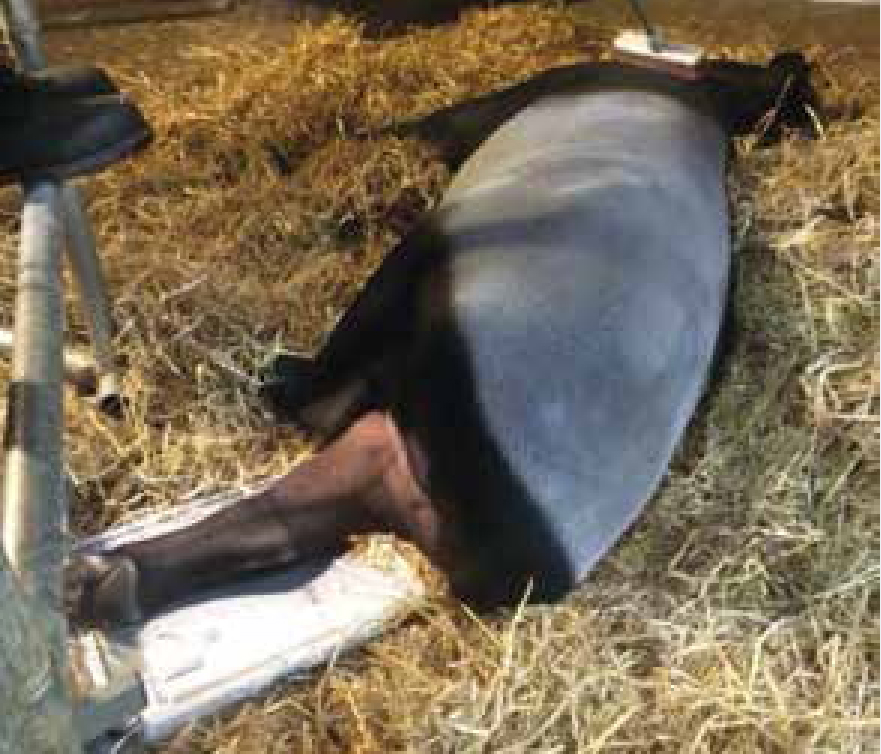
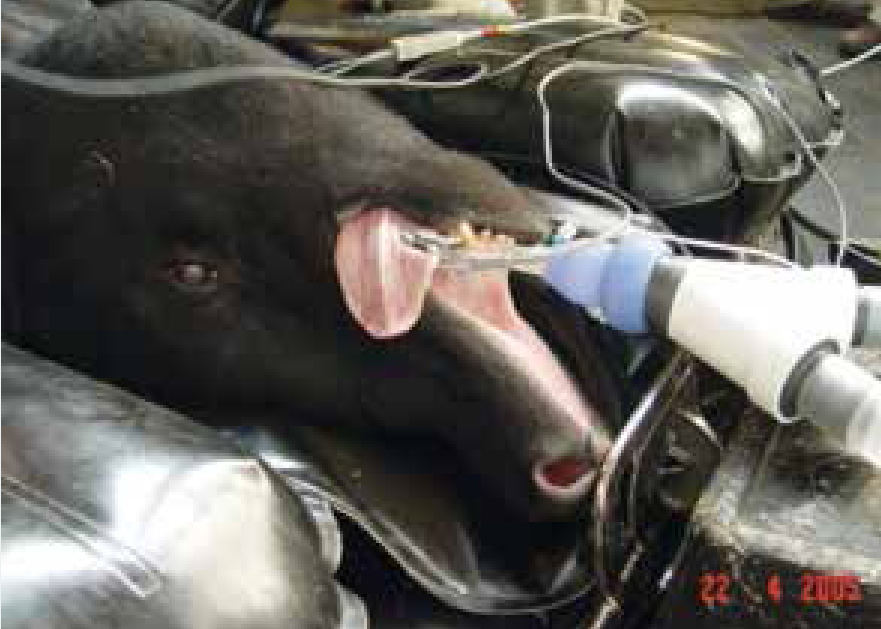
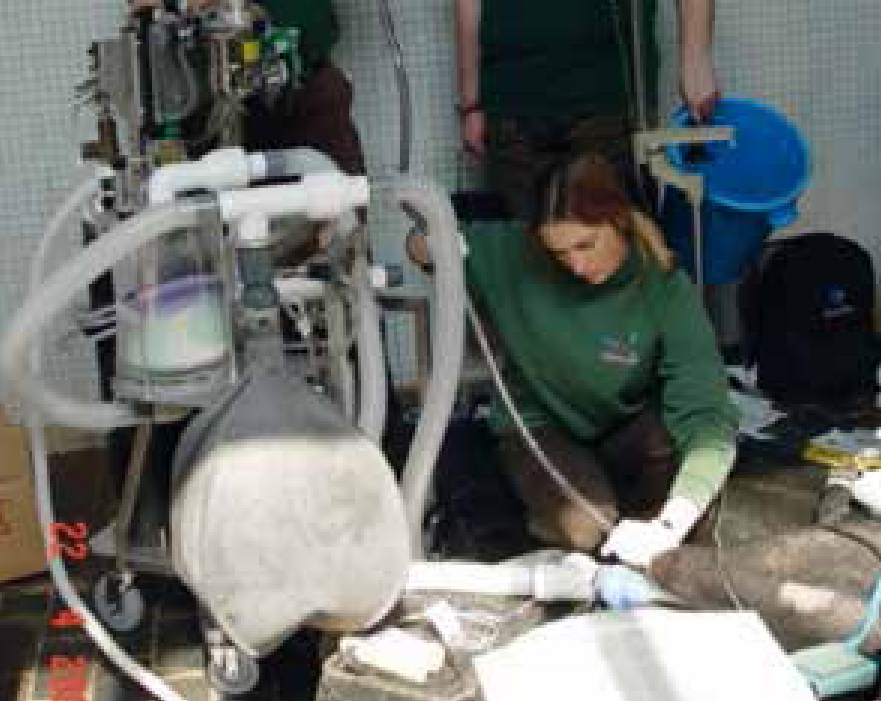
Galapagos tortoise (Geochelone nigra)
The finch response is a natural behaviour in Galapagos tortoises where they stand as high as they can and stretch out their neck. This is due to a mutualistic relationship with the Darwin finch. The finch lands on the tortoise and eats the ectoparasites, which are exposed when the tortoise is in this position.
This behaviour can be used to train for venepuncture and taking x-rays (Figure 3), among other things. The tortoises are rewarded with their favourite foods when they stop ‘finching’. Alternative methods used for blood sampling have been to pull out the extremities or tipping the toirtoise on it back, which can be traumatic for the tortoise. Branson et al (2016) ‘restrained (tortoises) by first coaxing them over the tines of a fork lift, and then elevating them several inches off the ground until they were suspended’, in order to take blood samples for field research. This would have been very stressful and potentially painful as their entire weight was suspended on the carapace.
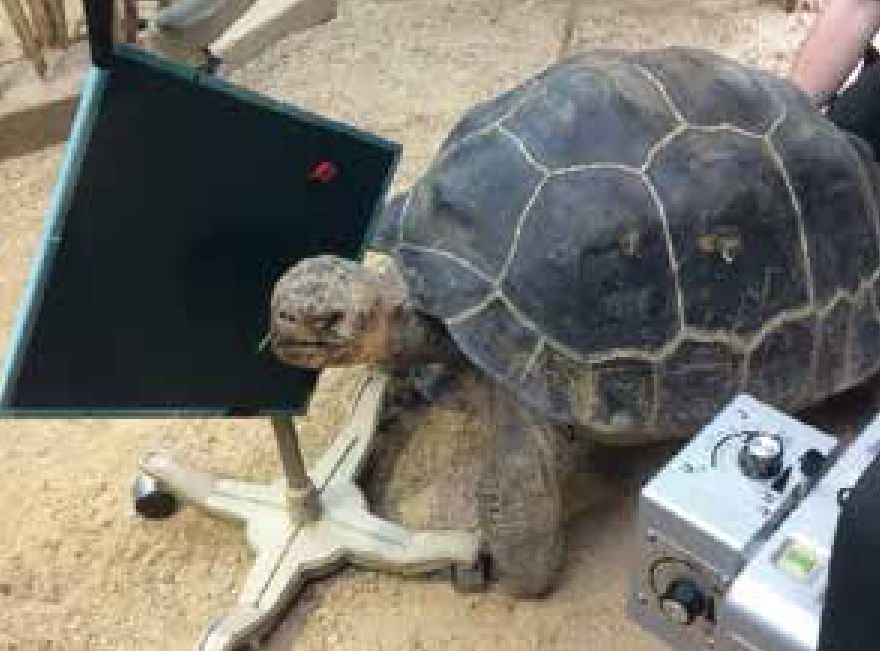
Tortoises use the movement from their limbs to alter the ceolomic cavity, this is essential for effective ventilation. This therefore is compromised when ties restrict movement and cause pain when fought against the rope. When positioned on its back visceral weight compromises ventilation reducing lung volume, tidal volume and perfusion, resulting in a difficulty breathing, pain and distress (Mcarthur, 2004).
Anaesthesia may be used as an alternative method to the finch reflex for blood sampling, but can be avoided using trained behaviour not only saving on time and money or resources, but saving the animal a stressful experience and long recovery.
Green winged macaw (Ara chloropterus)
Physical restraint is very stressful for all birds. Even when capture is swift auscultation is worthless as capture often results in open mouth breathing and tachycardia (Figure 4).
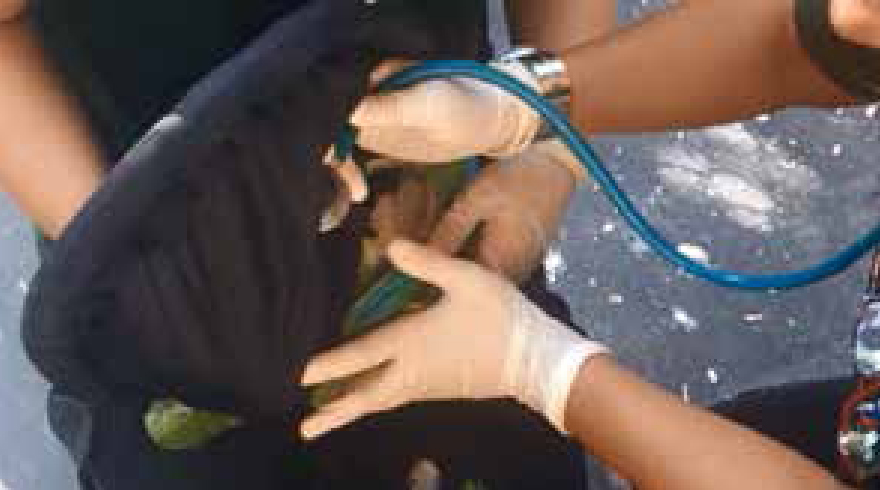
Ruby, a green winged macaw, was trained using operant conditioning to go into a box, turn around so the box door could be shut behind her. Operant conditioning is a particular stimulus response pattern which is reinforced (rewarded) and the individual is conditioned to respond. This training took 30 days to achieve. The time taken to train the bird may discourage people from training but it is a relatively short time and the benefits far outweigh the time taken.
Macaws are exceptionally intelligent and training programmes are used as part of their enrichment by stimulating their puzzle solving nature.
Anaesthesia is an alternative to training, and may be necessary for an adequate health check, but there is a risk of cardiac arrest which can be avoided for certain veterinary procedures. If trained and bonded with a keeper, induction will be less stressful as the animal has not been caught and this will remove the risk associated with having an anaesthetic.
Copper banded butterfly fish (Chelmon rostratus)
Copper Banded Butterfly Fish are often kept within zoological collections and moved between coral tanks as they act as natural parasite control. It has been noticed by aquarists that individuals become inappetent for a few days after they have been moved. This was thought to be due to the stress as a result of being moved.
Stress is a vital factor in fish health. The most basic stress response to stressors, e.g handling, is to escape from imposed danger which in captivity can take the form of the keeper attempting to catch the fish, either for examination or transfer. Preparing the body for escape involves a release of hormones. This has detrimental long-term effects on the fish; for example the release of adrenaline disturbs osmoregulation. Cortisol affects the white blood cells (lymphocytes) and reduces the effectiveness of the immune system. A fish that undergoes this response as a result of stress applied even for a short period of time can take hours or even days to recover its equilibrium (Andrews et al, 1988)
This individual, and many others at ZSL London Zoo, are now trained for movement. Initially they were desensitised to the jug (Figure 5), once the appearance of the jug was accepted they were rewarded with shrimp every time they entered it.
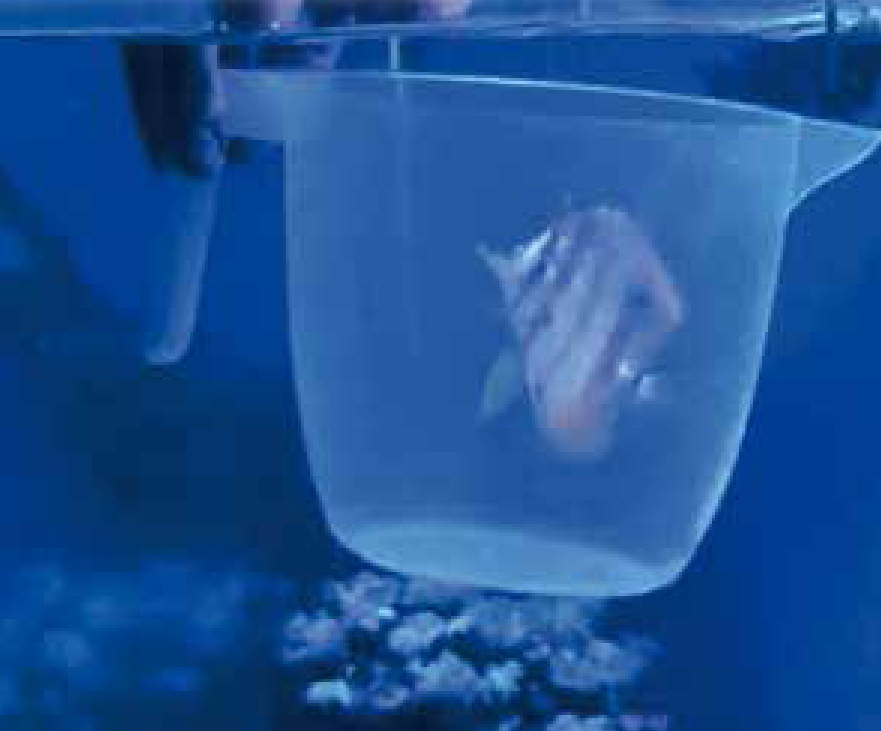
Zebra
In an attempt to try and quantify data to prove the hypothesis that any animal can be trained, and that training improves animal welfare, a group of zebra were studied that were being trained to receive their vaccines by hand injection. The group consisted of four zebra; Domino (10 year 9 month old male Chapman's zebra (Equus quagga chapmani)), Spot (10 year 9 month male Chapman's zebra), Kianga (6 year 6 month female Burchell's zebra (Equus quagga burchellii)) and Kabibi 6 year 7 month female Burchell's zebra) (Figure 6).
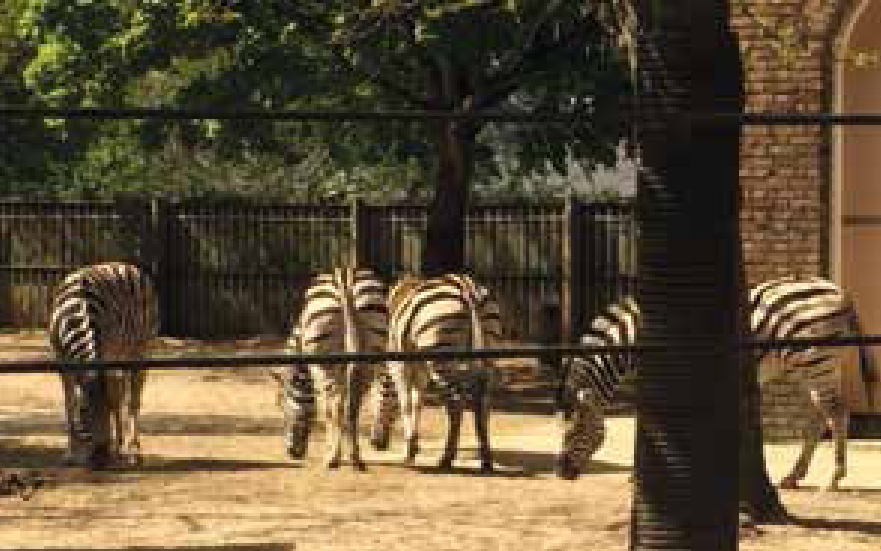
Method
It was decided that ethogram studies of each individual within the group would be taken on a normal day to establish a ‘normal behaviour’ base line. Then an ethogram would be taken after the event of hand injection to see if there were any behavioural changes.
Unfortunately only one zebra, Domino, was successfully trained for hand injection in the time frame before vaccinations were due (Figure 7). This resulted in the remaining three requiring darting to receive their vaccination (Figure 8).
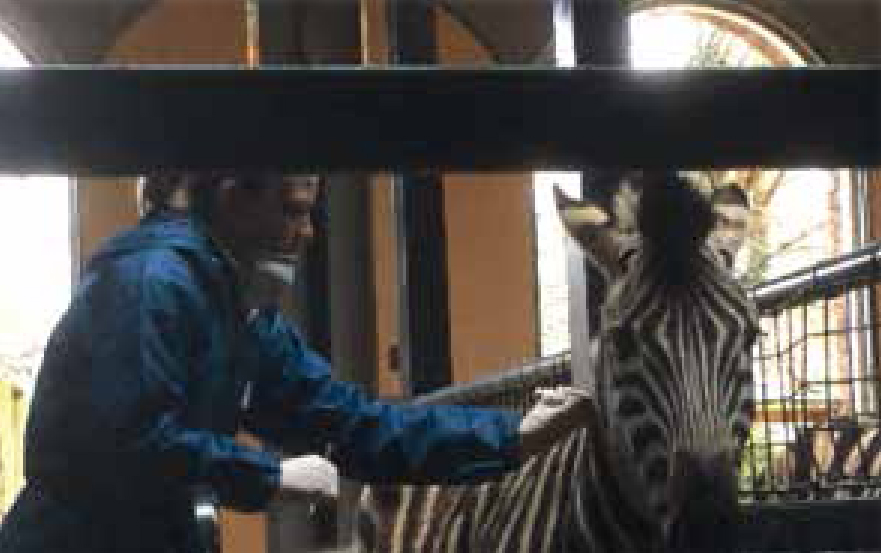
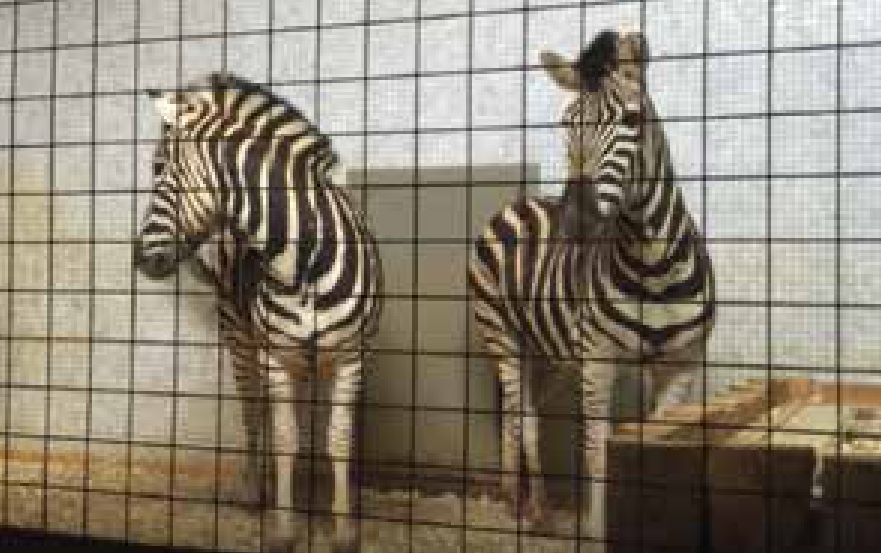
There are many theories as to why Domino trained more quickly than his conspecifics and these include temperament, previous experience, and hierarchical position within the group.
This altered the plan slightly, ethograms were then taken of each individual before and after their vaccination to see if any behaviour was altered by hand injection or darting (Figure 9).
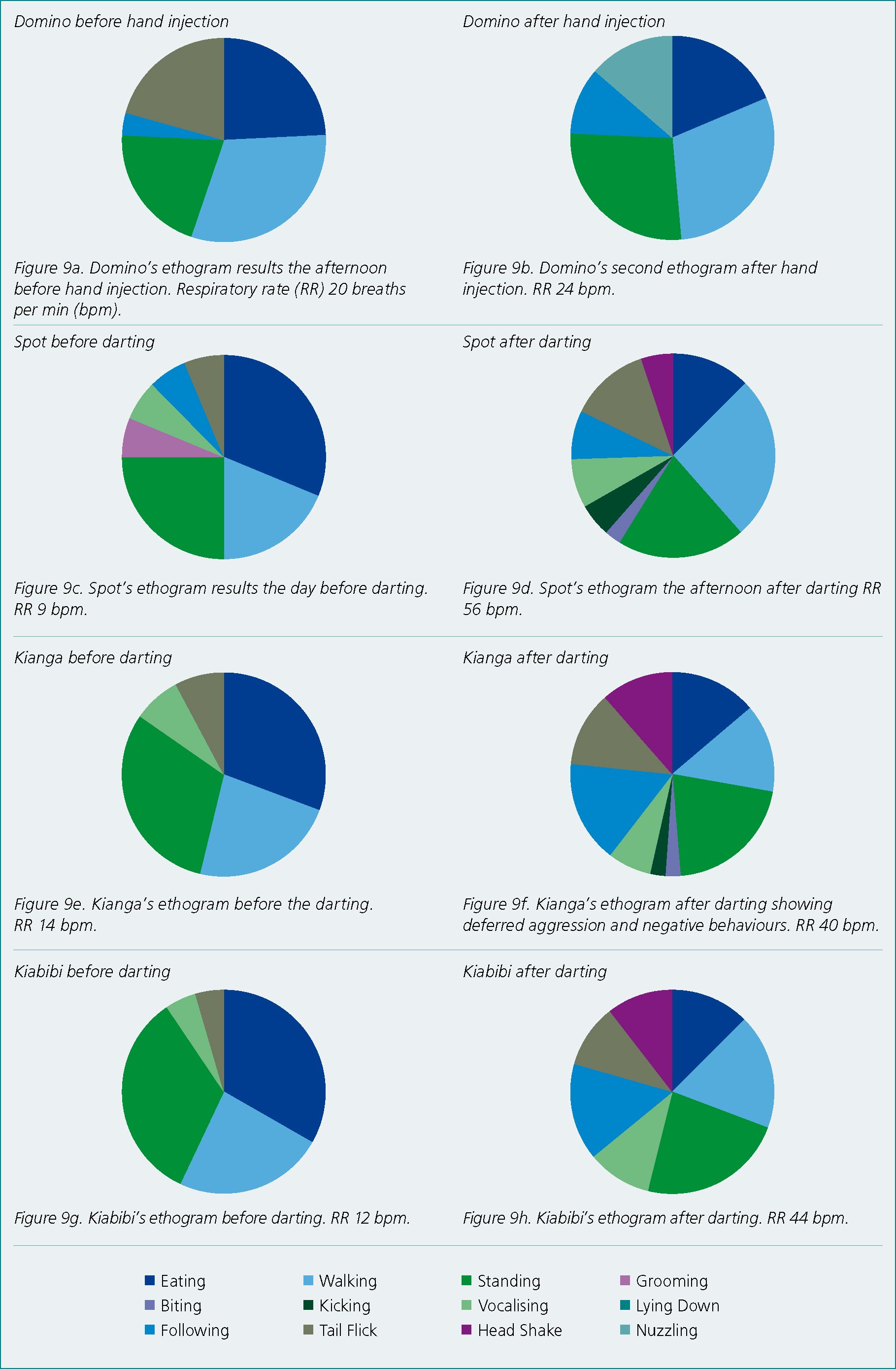
Data
One zebra (Domino) was hand injected successfully and did not show any changes in behaviour when the needle went under his skin. He continued to eat throughout and did not flinch or try to escape his station, which was open, meaning he could have gone outside at any point but chose not to.
Figures 9a and 9b show the result of the ethograms indicating his behaviours before and after the event as well as his RR. As seen on the graphs, there is little behavioural change and very little increase in RR (20 breaths per minute (bmp) to 24 bpm). This suggests that the event was not significant enough to elicit any negative behaviours.
Figures 9c and 9d shows deferred aggression following injection, with the zebra (Spot) kicking (twice) and biting (once) his companions. His RR also increased from 9 beats per minute to 56 bpm. This suggests that the event of darting was significant and caused the zebra to show negative behaviours due to stress. Similarly to the previous companion (Figures 9a and 9b) eating and standing were the main behaviours before the injection, and walking was the main behaviour after.
The zebra in Figures 9e and 9f (Kianga) behaved similarly to that in Figures 9c and 9d after being darted (Figure 9f); she reacted with aggression towards the rest of the group. Again, the RR was increased (14 bpm to 40 bpm) suggesting that the event was also stressful for her.
The behaviour shown in the final ethograms (Figures 9g and 9h; Kiabibi) is much the same as that shown in the other ethograms prior to darting, but after darting, unexpectedly, was the only one of the group darted that did not show aggression, but did show an increase in vocalisation. RR increased from 12 bpm to 44 bpm.
Discussion
It is evident from the resting ethograms that not one individual showed any stereotypical behaviours such as pacing back and forth or negative behaviours prior to the injection. No negative behaviours were seen in the zebra following hand injection and he not only chose to continue training after the event but did not choose to leave his station while the event took place. Each zebra darted had a change in behaviour, kicking, biting or simply an increase in RR and tail flicks.
Even after the hand injection and the event of being darted, all continue to be trained, showing the strength of their bond with the keeper.
This is just a preliminary study looking at the training that is currently undertaken at ZSL London zoo in order to reduce the stress imposed on an animal requiring a intervention. Only four zebra were included in the study over a limited time period which limits the reliability of the results. Further studies could be carried out over a longer time period including more animals and possibly using cortisol as a measurement of stress.
Conclusion
Using trained behaviour improves animal welfare. In each case study the use of trained behaviour has decreased the amount of stress imposed on the animal and its associated risk compared with the alternative methods that would need to be implemented in order to carry out any given procedure. Giving the animal control of the situation and an understanding not only forms a bond but provides enrichment. Each individual after the event continued to train, suggesting that the animal was not under stress. Further large scale studies would be useful.
Training can also be undertaken with companion animals and veterinary nurses can help owners with this. Veterinary professionals have a duty to improve animal welfare wherever they can.

